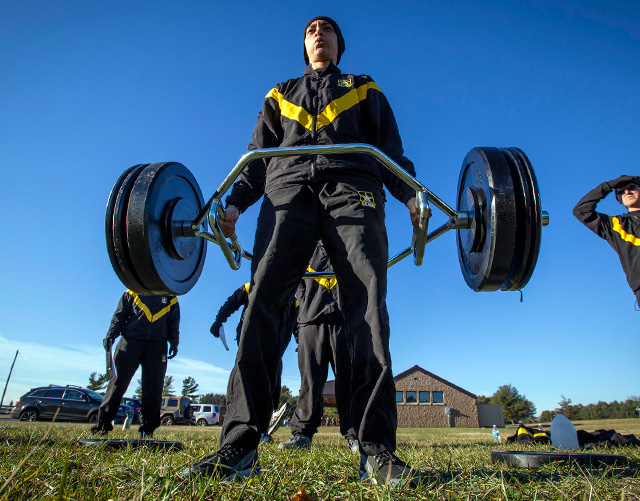This is a specific repetition maximum (RM) fitness test, assessing maximum strength for the lower body (see the general description of 1RM fitness tests), using the deadlift exercise.
test purpose: to measure lower body maximum strength
equipment required: various free weights and a deadlift "hex-bar" bar (the bar splits around the subject so they can stand in the middle).
pre-test: Explain the test procedures to the subject. Perform screening of health risks and obtain informed consent. Prepare forms and record basic information such as age, height, body weight, gender and test conditions. See more details of pre-test procedures.
procedure: After an adequate warm up, the subject stands inside the open space of the bar, with feet shoulder-width apart. The knees should be in line with the toes. Bend at the hips to lower the body and grasp the bar. Ensure the head and neck are in a neutral position with eyes facing forward (avoid rounding of the spine). To perform the deadlift, pull the bar straight up by extending the knees and hips in a slow, smooth and continuous movement, until the legs are straight and the body upright. During the lifting motion, the subject must not allow the knees to collapse inward, and the shoulders must remain above the hips at all times. The heels must also maintain contact with the ground throughout the lift.
 deadlift max-lift using a Hex Bar
deadlift max-lift using a Hex Barthe test: start with a 'check' 3-rep test with the weight of 40lbs or less, to check for correct technique. Then one repetition (new recruits) or three repetitions (annual assessments) is performed for each weight in sequence. For the new recruits, the weights used are 120 lbs, 140 lbs, 160 lbs, 180 lbs, 190 lbs, 200 lbs, 210 lbs, and 220 lbs. Less than 1 minute rest is allowed between reps. If a weight is failed, another attempt may be made.
scoring: the maximum weight lifted is recorded. To standardize the score it may be useful to calculate a score proportional to the person's bodyweight.
advantages: the required equipment is readily available in most gymnasiums, and the test is simple to perform.
disadvantages: This test should only be performed by those with a good deadlift technique. If the subject is not able to show the correct technique during the warmup, the test should not proceed.
comments: The results of this test may be specific to the equipment used (height of bench, variations in weights), so is best to use the same equipment for test-retest measures. The warm-up procedure should also be recorded and repeated with further testing. If any variation in technique was allowed, this should be recorded on the results sheet for referral when the test is repeated.
variations / modifications: the US Army use this test with either 1 or 3 maximum repetitions, depending on the level of the soldier.
The Test in Action
- This test forms part of the fitness testing for the US Army.
Similar Tests
- 1RM Squat — maximum lift for one squat repetition.
- 1RM bench press test — measure of the maximal weight you can bench press with one repetition.
- Lat Pulldown 1-Rep Max Test — one-repetition max test using the lat pulldown exercise.
Related Pages
- General description of 1RM fitness tests
- A calculator to estimate 1RM
- The Sport of Power Lifting Dreadlift
- US Army testing discussion and scoring
- About the equipment: Trap (Hex) Bar
- Powerlifting Deadlift Sport
- Deadlift exercise technique


 Current Events
Current Events